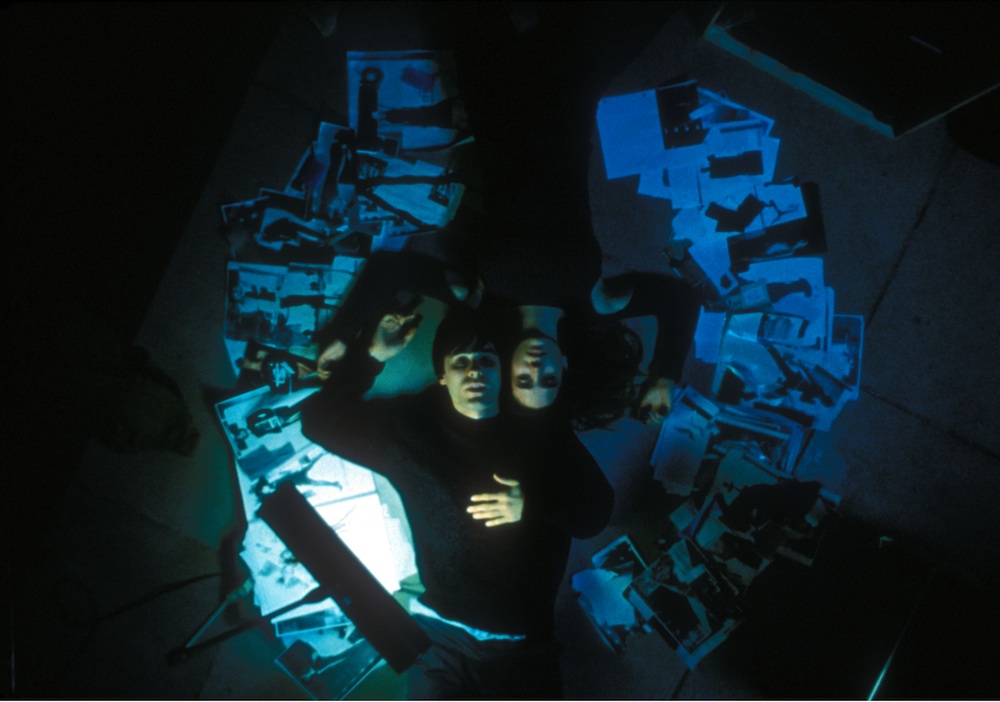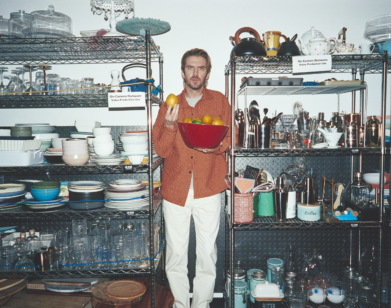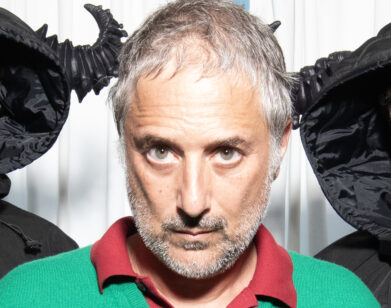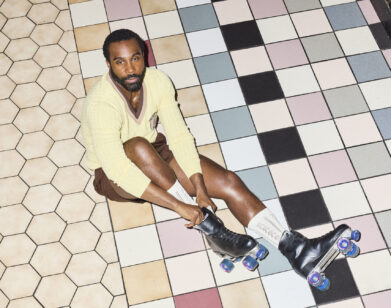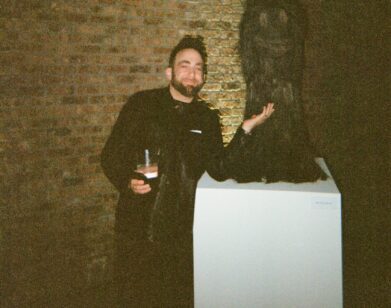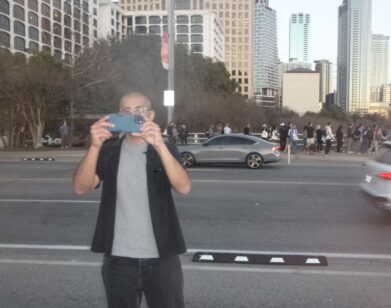Darren Aronofsky
You can’t look at the Noah story and not see some kind of environmental connection. The Creator wants to start over. Noah AronofskY
Darren Aronofsky is putting together the type of canon of which adjectives are made (see: Lynchian, Felliniesque, Kubrickian). Plucking story subjects from all over the genre cafeteria, the 45-year-old director from Manhattan Beach, Brooklyn, has managed over the course of six feature films to define his own propulsive visual vocabulary. His most financially successful film to date, 2010’s Black Swan, is a campy fairy tale set in the world of ballet. His 2000 adaptation of Hubert Selby Jr.’s bleak Requiem for a Dream (2000) is among the most ravishingly beautiful movies you cannot bear to see twice, and his latest film, Noah, out this month, is an Old Testament epic blockbuster that also happens to be a timely meditation on environmental crisis. His talent and ambition, in other words, are biblical. But the most Aronofskian thing about Aronofsky might be what Brad Pitt once gently described as his “tenacity,” i.e., obsessiveness. Even among the notoriously bloodshot brotherhood of filmmakers, Aronofsky is considered something of a modern-day grail hunter, chasing his passion projects to the ends of the earth.
Beginning with his shocking debut, 1998’s Pi, about a mathematician’s quest for the solution to the universe, for which Aronofsky won the Directing Award for dramatic film at the Sundance Film Festival, his characters have shown a drive similar to that of their creator. Whether chasing the equation for god (as in Pi), the American Dream (Requiem), immortality (The Fountain, 2006), or artistic sublimity (Black Swan), Aronofsky’s heroes are all obsessives, often to the point of madness. (Even Mickey Rourke in 2008’s The Wrestler, the humblest-seeming work in his canon, aspires to a bit of all the above.)
Aronofsky, who studied anthropology and film at Harvard before going to grad school at the American Film Institute Conservatory, remains passionate about the natural world. And his stylistic signatures—shuffle cuts underscoring the mechanized habits of man; time-lapse shots of plants erupting into bloom—play with the balance and fragility of our relationship with the planet, a relationship that actually caused a bit of trouble on the Oyster Bay, Long Island, set of Noah in 2012. In a too-crazy-to-be-made-up case of life imitating myth, Hurricane Sandy came while the crew was filming some of its final scenes with Russell Crowe as the legendary ark builder. The rains and tides wreaked havoc, but when the clouds cleared, as it is written, the ark stood.
Musician Patti Smith wrote a lullaby called “Mercy Is …” for the movie, which she recorded with two-time Aronofsky collaborators the Kronos Quartet. This January she visited the director in his Williamsburg office, where he is recovering after three years of (computer graphically) making it rain.
DARREN ARONOFSKY: Okay, this is Darren Aronofsky and Patti Smith—take infinity.
PATTI SMITH: [laughs] Okay.
ARONOFSKY: So, what did you think of working with the Kronos Quartet?
SMITH: I loved working with them. I know their work so well and we’ve often talked about working together. I was a little concerned that I would not know where to begin and end, you know, not having the usual bass and—
ARONOFSKY: Because a string quartet is not a guitar.
SMITH: Not even a guitar, but a bass and drum. I’m rhythm-oriented. But they’re so tight as musicians that I could feel us listening to each other. It was like driving. I mean, I don’t drive, but I know the concept of driving—you’re adjusting every second.
ARONOFSKY: When we first talked about it, [composer] Clint [Mansell] considered recording you and Kronos separately. Then someone reminded him that bands actually used to play together. [laughs]
SMITH: Oh, yeah, we like to do it live.
ARONOFSKY: Which is great, but I don’t think most music gets made that way anymore. It’s mostly performed to a click track.
SMITH: I can’t bear working with a click track, we’re not click track people. But for “Mercy Is …” we all got in one mind because the song is delicate; it’s not a song that showcases a vocal or some virtuoso. The whole agenda was to give Noah the song to sing to a child that his father sang to him.
ARONOFSKY: It was such a hard assignment I gave you, which was “write a lullaby that is timeless.” We don’t know how long ago the story that’s in this movie took place, so how do you write a lullaby that doesn’t date?
SMITH: Well, a lullaby should be timeless because it’s a timeless concept—the birth of the child. When I was working on the lyrics, I thought of all the lullabies we learn as children: “Away in the Manger,” William Blake’s lullabies. I realized that the key to lullabies is simplicity.
ARONOFSKY: I remember when we bumped into each other in Venice and wandered the streets …
SMITH: Isn’t that a great thing to say? “I remember when we bumped into each other in Venice and wandered the streets.”
ARONOFSKY: We got lost in the streets of Venice. I was having that problem of how to create a song, and you told me your connection to lullabies. I was, like, “Oh! This is a coincidence.”
SMITH: I’ve always loved lullabies. My mother had a beautiful voice and sang lullabies to us; I sang them to my siblings and to my own children. And I love the story of Noah. I love the idea of this very stoic, driven man who has one of the most terrible tasks in human history, who has to separate himself from all of mankind while they’re destroyed.
ARONOFSKY: When I started working on Noah, I didn’t really understand how dark the subject is. Our main exposure to Noah is as a story for children. The actual story of Noah is not that. It’s the fourth story of Genesis, right? The first story is creation. The second story is original sin—the creation of Adam and Eve and the first sin. The third story is the first murder—Cain kills his brother, Abel. And then, ten generations after Adam, the Creator is so fed up with the world that he wants to destroy it and start over. All the animals make it onto the ark, but only two each, so there’s all those other innocent animals that were drowned. Then you think about babies and young children, all that blood. It’s a very sad and dark story.
SMITH: I started going to Bible school really early in life. Being raised a Jehovah’s Witness, I had to read the Bible over and over. These stories were so horrifying and really difficult to reconcile. Because, for me, Noah wasn’t the story of, you know, the graham cracker box with the little animals [Aronofsky laughs], it was horrifying. I would ask the same questions as a child. “Well, what about the little kids? What about the dogs and cats?” But you also made me think of something when you said god was so fed up and he wanted a clean slate. That’s what artists, creators, do. You look at paintings like de Kooning’s series The Women. He repainted the canvas of Woman, I so many times. The first one must have looked beautiful—why did he destroy that? It just wasn’t as he pictured it. He paints over. And the second one probably looked even more wonderful. But he completely destroys that until he gets to the point where he feels satisfied. But that’s what artists do, that’s what poets do—we all do it. We start with something, and sometimes we destroy everything that we’ve made in order to get to the core place where we started from.
ARONOFSKY: Unfortunately, when you’re working in film, it’s this huge machine, and you’ve got to get everyone right there, so you get kind of locked into things. I’m not sure where the artistry in filmmaking is. It’s usually that moment when you’re on set and you’re working with the actors. That’s the time to play around, the moment of theater. And then you can shape things. But a lot of it is just managing stuff. It’s upsetting because you get away from the core.
SMITH: But the thing is that you are the core. I was thinking about your films. In all your films there is the quest. In Pi, he’s searching for the ultimate number that’s going to unlock all the patterns of the universe. In The Fountain there is a quest to find where past and future can be alive in the present through imagination, through god. In the Requiem movie, it’s like three minds entering this Utopian dream that makes happiness possible. In every one of your movies, there’s the core-belief.
ARONOFSKY: I don’t know where it comes from. It can be an image. It can be an idea. It’s always a feeling, and it’s usually right above my stomach—it’s somewhere there inside—and that’s the heat, that’s where you get the warmth. When you make a film, everybody is saying no to you for two years, and you’ve got to somehow get out of bed and be like, “You know what? Fuck everyone. This is what we’re doing, we’re going to keep going forward and doing it.”
SMITH: There’s the same kind of quest in Black Swan. She wants to be the greatest dancer, the greatest black swan—as high as she can go, into the realm of madness. To me, she seems like you. [Aronofsky laughs] I mean, without the terrible psychosis.
ARONOFSKY: That is how I see myself, too, when I look in the mirror.
SMITH: We have to believe, as creators—just like a doctor doing heart surgery has to believe that he can save that person’s life. You have to believe that your pursuit is not just a noble pursuit, but a necessary and inborn pursuit to uncover something.
ARONOFSKY: Yes.
SMITH: To find just a glimmer, a moment. In any performance, you’re on stage for two hours, and there’s 40 seconds or maybe a whole five minutes where you feel like the whole universe is in place, and you’ve gone even beyond the universe that you know.
ARONOFSKY: Now, hold on, when you say “you” …
SMITH: I mean you.
ARONOFSKY: But in that moment, are you there, or do you disappear?
SMITH: I have disciplined myself when I’m working. As a child I was such an intense daydreamer; I could be so gone that I had to be smacked to come back. They were really worried that I had some kind of catatonia or something because I would go so far out. Because all I wanted to do was talk to god as a child. But when I discovered art, I realized that one could keep that search going within creation. But I also realize that in order to create the art, you have to stay, you can’t go too far.
ARONOFSKY: So you’re keeping a foot on the stage.
SMITH: Yeah, like Coltrane, he talks to god. He starts playing his solo, he might play for 14 minutes. For 14 minutes, it seems like he’s talking to god, but he always takes a hold of the melody.
ARONOFSKY: Yeah, and comes back.
SMITH: And comes back because that’s what we have to do. That’s your responsibility as a director, as an artist, as a performer. Your responsibility is back again to your people.
ARONOFSKY: Does that only happen for you in performance, or writing?
SMITH: It can come from different things. Sometimes I get lost in watching a film. The sorrow, or the frustration, is when it doesn’t happen for a long time.
ARONOFSKY: I remember the few times that happened to me in writing, where you basically start writing and you look at the clock and six hours have gone by and you’re, like, “Whoa! What the hell just happened?” And that piece ends up in the final product even though the final product is three years away. It doesn’t get rewritten. It came out the right way. But that’s happened to me so few times in my life.
SMITH: Those moments—when Natalie [Portman]’s character merged with the swan in Black Swan; where Noah feels the Creator speak to him; when the astronaut finds his love in The Fountain—I’m open to those moments because I’m looking for the same thing. And when someone else has that same vocabulary, I think it’s blessed, and I think that this is something that should be shared with people. But what was the impulse that drove you to direct? To me, it seems so immense. Just having a rock ‘n’ roll band, or to go from the solitude of writing and to having to collaborate, is almost schizophrenic.
ARONOFSKY: Growing up in South Brooklyn, I saw movies, and I wasn’t even that crazy of a movie guy. I probably had a sense that there was a voice behind E.T. [1982] and Jaws [1975] that was related. But what a director did was outside anything I thought about until I got into college. This was before Sundance took off and all these independent filmmakers were making things by themselves—I mean, I was sort of at the front end of that. I think I came to filmmaking through writing. I started to write, and people, teachers, responded to my writing.
SMITH: You had something to say.
ARONOFSKY: I was always writing about the connection between man and nature. I grew up in a neighborhood that was right on the beach, but the beach was not like a beach you would imagine—there was a lot of pollution. And the most magical thing to me as a kid was sea glass, so I wrote about that a lot. In seventh grade I had a magical teacher, her name was Mrs. Fried. She wore only pink, she drove a pink Mustang, and she was half out of her head. But very inspiring. And one day she said, “Take out a paper and pen and write something about peace.” For some reason I wrote a poem on Noah—I don’t know why I chose Noah—and it turned out it was for a contest for the UN. I ended up winning and reading the poem in front of the UN. I remember Mrs. Fried telling me, “When you write your first book, dedicate it to me.” That was like, “Whoa.” I was 12 or 13 years old. So I started to write poetry and fiction, even though I was really into biology because my dad was a science teacher. I kept writing all those years. At a certain point when we weren’t sure if we would ever make a film of Noah, we started doing a graphic novel out of the script. I said, “I’ll dedicate it to Mrs. Fried.” I called my mom, who’s a retired schoolteacher, and I said, “Do you think there’s any way I could find Mrs. Fried? I’d love to send her a copy of the comic when it comes out.” And through her connections with the Board of Education, we found her. She’s retired, and I got in touch with her and I invited her to set, and then I actually put her in a scene with Russell.
SMITH: Oh, that’s awesome!
ARONOFSKY: We ended up making her a one-eyed evil crone. And now she tells the story of how a student reached out to her and how it changed her life. But, because of that poem, Noah was this sort of patron saint in my life. When I finished Pi and I started to think about what was next, I was like, “Wow, it’s interesting that no one has done a film of one of the greatest stories ever told.” Even if you’re not a Jew, a Muslim, or a Christian, you likely have a flood story in your culture.
SMITH: This film, and this story from so early in human history, is a metaphor for what’s happening to our world today.
ARONOFSKY: You can’t look at the Noah story and not see some kind of environmental connection. The Creator wants to start over. He wants creation to be given a shot at survival, and the true enemy is the wickedness of men. I remember in elementary school they had a list of endangered species. It fit on a page and you would see the tiger and you would see the elephant, and then you learned about the dodo bird. Now it seems like you can’t find a creature on the planet—unless it’s an invasive species—that isn’t somehow endangered. I went to Prince William Sound as a kid with a school group, and we were hanging out in these glaciers, just us, the orca, and the bald eagle. Two years later the Exxon Valdez spilled millions of gallons of crude into that area and changed it forever. Our fingerprint is everywhere in the world. People have been screaming about the end of times forever, it’s always the end of times. But there’s just so much evidence that the world is changing so radically right now. How much can the world take?
SMITH: Noah, with all his conflicts, has a conscience. And that is one of the most beautiful and compelling things to see on screen.
ARONOFSKY: In the story, which is only a few chapters long in Genesis, Noah never even speaks until after the flood—but when you have Russell Crowe, you’re going to make him speak. The second thing Noah did after the flood is he made wine and got drunk. It’s the first mention of wine in the Bible. After that huge ordeal, he gets drunk. It makes you wonder if it’s survivor’s guilt.
SMITH: I don’t know where it comes from, but Russell can often look like a man who is suppressing tears. He and Jennifer Connelly are together again. They were great in A Beautiful Mind, each represents something important. In Noah, Jennifer’s us. If Russell has to take on the inner mantle of god, she takes on the inner mantle of the human being.
ARONOFSKY: It’s the battle of justice versus mercy. In Genesis it says that Noah was righteous in his times. You think you sort of know what righteous means, you know, if you listen to a lot of Bob Marley. [laughs] According to all the biblical scholars we talked to, righteousness is the proper balance of justice and mercy. If you think of that, as a parent, you know that if you have too much justice and you’re too strict, you destroy a child. If you have too much mercy, as a parent, you destroy a child as well. A big part of this movie is Noah finding mercy for man.
SMITH: Do you know what you’re going to do next?
ARONOFSKY: I don’t know. This film … I’ve been working on it for three years or so. I’m at the point where I’m drained.
SMITH: Now you should go into a cave and drink some wine like Noah.
ARONOFSKY: I’m going to go travel for a bit, live for a little bit, and try to find something that keeps me awake at night again.
SMITH: Obsession.
ARONOFSKY: Do you ever lose the obsession at the end of a project?
SMITH: I find it painful when I’m without anything. But I work in multiple fields. If I can’t write, I find myself taking photographs. I can go on the road and perform. But the most important thing for me is writing, and when I hit those walls, it’s painful. I’ve learned when I have those times to go by the sea. The sea is greater than us—it has its rhythm, its art. It comes with our earliest memory, of respiration, breathing in and out.
ARONOFSKY: I grew up next to the beach, and when I was in China for a film festival, I had a serious Chinese psychic read my and my fiancé Brandon [Milbradt]’s fortune. The psychic said to always live near the water.
SMITH: You took a big dose with Noah, that’s for sure.
ARONOFSKY: Exactly, although a lot of it was digital.
SMITH: Listen, I saw the ark. That was not digital. When I first saw the immensity of it, Jennifer came up to me and said, “It’s big, right?” It really made me cry—all of the materials and craftsmanship that went into building that. And then we had Hurricane Sandy, and with all of the destruction, the ark stood.
ARONOFSKY: Yeah, the ark stood. It was built in a place where there’s a lot of old trees, and the trees came down, so it took us a long time to find out that the ark was okay, but the ark weathered Sandy very well.
SMITH: When you look at pictures in the Bible, you always see the cute little ark with cute little animals. But when you read the Bible, the ark is a huge rectangle.
ARONOFSKY: Yeah, it’s a box. A coffin.
SMITH: Talk about metaphors. But it’s the coffin and the opposite. You remember Ishmael holds onto Queequeg’s coffin and he survives the wreck at sea.
ARONOFSKY: When people think about the ark, they’re always thinking about all the thousands of years of religious iconography of a ship with a bow and a deck, where Noah and the giraffes could walk around. In the actual written text it is basically described as a long, rectangular box.
SMITH: It’s cages, really.
ARONOFSKY: We really wanted to rethink all of that, all those expectations of what biblical times might’ve looked like. I didn’t want sandals and robes and long white beards, because there’s no reason why that’s more real than anything else. And a Middle Eastern setting didn’t make sense for the Noah story because the Noah story is, it’s prediluvian. Who knows what the world looked like before the flood? Before the flood, there were no rainbows, so what did the sky look like? That was one of the reasons we went to Iceland. If we’re telling a story that happened a long time ago, we want the newest earth possible. The land in Iceland is actually newer than any land elsewhere except for other volcanic places, like Hawaii. The earth is spreading there. The volcanoes are coming up. All that land is new.
SMITH: It’s like paradise on the moon. Also, there are giants in the story of Noah. There are the massive offspring of angels described in the Bible.
ARONOFSKY: The Nephilim, yeah. A lot of people don’t learn about the Nephilim, which were the children of human women and fallen angels. You know, [artist and illustrator] R. Crumb did a whole illustration of Genesis. And he didn’t go away from the text; he was totally truthful. Reading through that, I was like, “Oh, wow, it’s a comic-book version of the Bible.” There’s a lot of heavy-duty stuff that goes on that doesn’t make it into Sunday school.
SMITH: I’m hoping that the film will make people think about what’s happening to our world, what’s happening to our planet.
ARONOFSKY: Thank you, Patti. I love you.
PATTI SMITH IS A NEW YORK-BASED MUSICIAN, POET, WRITER, AND VISUAL ARTIST. HER MEMOIR, JUST KIDS, WAS PUBLISHED IN 2010.

